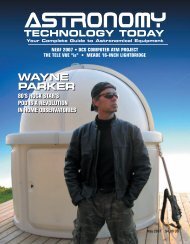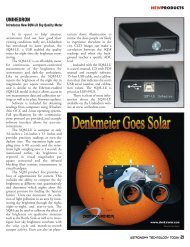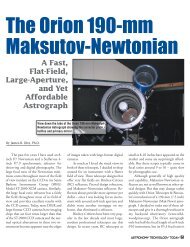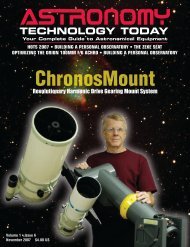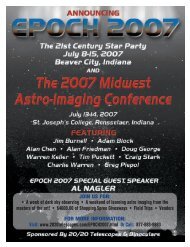iOPTRON - Astronomy Technology Today
iOPTRON - Astronomy Technology Today
iOPTRON - Astronomy Technology Today
Create successful ePaper yourself
Turn your PDF publications into a flip-book with our unique Google optimized e-Paper software.
A Hot Topic<br />
Active Cooling of a Primary Telescope Mirror<br />
By Steven Aggas<br />
Cooling glass, specifically a<br />
telescope mirror, has been the<br />
topic of many conversations at<br />
star parties and Internet forums,<br />
covering not just the<br />
boundary layer of warm air,<br />
which acts like a weak lens to<br />
deform the view before it<br />
reaches the eyepiece, but also<br />
concerning removing the<br />
source of that boundary layer:<br />
the excess heat load of the glass<br />
mass of the primary-mirror<br />
substrate. More telescopes than<br />
ever before are equipped with<br />
fans located at various points to<br />
address both the warm-air<br />
boundary layer and excess heat<br />
load, and, in some instances,<br />
fans are simply incapable of adequately<br />
addressing these thermal<br />
issue.<br />
Take a look, for instance,<br />
at the two graphs provided as<br />
Figures 1 and 2, derived from<br />
Robert Houdart’s telescope<br />
mirror-cooling calculator freeware,<br />
MirrorCooling (www.<br />
cruxis.com/scope/mirrorcooling.htm).<br />
The graphs differ<br />
only in the thicknesses of the<br />
mirror substrates for which<br />
cooling characteristics are modeled,<br />
30 mm versus 50.8 mm,<br />
two typical mirror thicknesses.<br />
The graphs demonstrate the<br />
additional cooling challenge<br />
faced as substrate thickness increases.<br />
As modeled in Figure 1,<br />
a mirror of 30-mm thickness<br />
takes approximately 140 minutes<br />
for surface and core temperatures<br />
to cool within 1°C of<br />
ambient without active cooling<br />
measures, while Figure 2<br />
demonstrates that, also sans active<br />
cooling measures, a mirror<br />
of 50.8-mm thickness has still<br />
not achieved core and surface<br />
temperatures within 1°C of declining<br />
ambient, even after 240<br />
minutes.<br />
Now, what if your primary<br />
mirror is a combination of<br />
thicknesses and/or has slightly<br />
more glass than your average<br />
primary? My primary mirror is<br />
36 inches in diameter and 6<br />
inches thick but features nineteen<br />
5 inch-deep hexagon holes<br />
to reduce its overall mass. The<br />
fans installed in my telescope<br />
would be adequate for following<br />
the gradual drop in ambient<br />
temperature on a given<br />
night … if it was already cooled<br />
to the starting ambient temperature.<br />
But, when dealing with<br />
250 pounds of glass, there’s a<br />
lot of initial stored heat that<br />
would have to be gotten rid of<br />
first!<br />
I had an expectation, a<br />
goal really, of wanting to spend<br />
no more than one hour cooling<br />
the primary mirror to less than<br />
1°C of night-time ambient air<br />
temperature. I’ve installed ther-<br />
Figure 1: With an ambient temperature that steadily declines from 10°C<br />
to 5°C over the course of 4 hours and without active cooling measures,<br />
a mirror of 30-mm thickness reaches core and surface temperatures<br />
that are within 1°C of ambient within approximately 140 minutes.<br />
Figure 2: With an ambient temperature that steadily declines from 10°C<br />
to 5°C over the course of 4 hours and without active cooling measures, a<br />
mirror of 50.8-mm thickness reaches has not achieved core and surface<br />
temperatures that are within 1°C of ambient even after 240 minutes.<br />
<strong>Astronomy</strong> TECHNOLOGY TODAY 53



